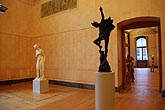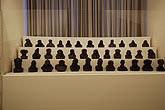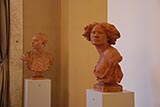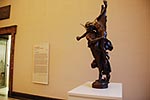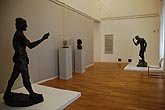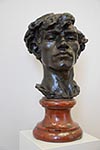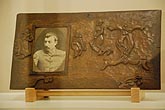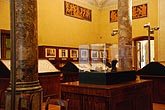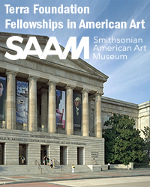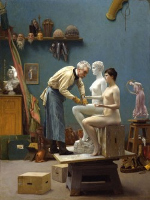The browser will either open the file, download it, or display a dialog.
|
Elegant // Expressiv: Von Houdon bis Rodin, Französische Plastik des 19. Jahrhunderts Elegant // Expressiv: Von Houdon bis Rodin, Französische Plastik des 19. Jahrhunderts |
|||||
| In June of 2007, the Société Nationale des Chemins de fer Français (better known as the SNCF, or the French National Railway Company) gave Parisians the gift of easy travel between France and Germany. The new TGV Est Européen allows for swift travel to places such as Karlsruhe, Germany, now only three hours from the Gare de l'Est station in Paris (previously the trip took over five hours), and, once the high speed line is completed, travel between the two countries will be even faster. Among the reasons to take the new TGV was the exhibition Elegant // Expressiv: Von Houdon bis Rodin, Französische Plastik des 19. Jahrhunderts, presented by the Staatliche Kunsthalle Karlsruhe and organized by Siegmar Holsten with the assistance of Nina Trauth, a salute to French nineteenth-century sculpture (fig. 1).1 | |||||
| The Staatliche Kunsthalle Karlsruhe, which borders the park and forest that contain the castle (schloss) that marks the center of this eighteenth-century city, is one of the oldest museums in Germany and contains a large permanent collection of German, French and Netherlandish art. The museum's strong collection of nineteenth-century French sculpture and prints defined the core of the Elegant // Expressiv exhibition, a show which began in the older part of the large museum building, in a set of rooms that were initially built specifically for the display of sculpture. The caramel-colored walls were originally designed to offset the white of marble sculpture and help the works powerfully project themselves in front of the viewer (fig. 2). Above the doors and along the walls' top edges were fresco paintings by Moritz von Schwind (1804-1871), best known in Austria and Germany for his illustrations of Grimm's fairy tales and his work for King Ludwig I of Bavaria. Other than Schwind's work, there were no paintings or other comparative materials on the walls of the exhibition, save for a thin banner or two of wall text introducing each room's theme and explaining the grouping of the sculptures. | |||||
| The organizers of this exhibition diligently worked to keep distractions to a minimum. We have all seen the global museum-going public who stand in a muddle, glassy-eyed in front of a masterwork that they are not really looking at, with their ear glued to an audio guide, or those who walk up to the wall text, read it thoroughly, and then walk away, without lingering half as long, or at all, in front of the work that the text described. This is a symptom of our technologically- and information-saturated modern world. With this in mind and in an attempt to aid viewers in concentrating on the sculptures, there were no identification labels of any kind in the exhibition. Not even the artist's names or the sculptures' titles were placed next to works. Instead, visitors were provided with a small begleitheft (handbook), keyed to numbers next to the works and including only the artist's name, the title of the work in German and French, the medium, date and the collection from which it hailed. In a few cases a sentence was provided after the identification information to give further details about an artwork or its artist where it was felt to be necessary. Audio guides were also available. | |||||
| At first one might think that the numbers next to the sculptures corresponded only to the audio guide as is usually the case, but only numbers with an audio guide symbol next to them were discussed in the recording. According to the museum's media department, the use of the begleitheft was experimental. Although the modern museum visitor, who is usually given all of the information about a work of art directly to eye and ear, may be annoyed at the prospect of having to look up the basic information for the sculptures they were most interested in, the use of the begleitheft actually gives the sense of viewing the works in the way a nineteenth-century visitor would have: the Paris Salon exhibitions, where many of the works in the exhibition were first shown, always had a livret, which functioned in much the same way. It is an experiment that one hopes other museums would consider trying and that can truly benefit those viewers who wish to quietly contemplate a work of art without the numerous distractions that clutter most large exhibitions today. | |||||
| Elegant // Expressiv was not organized according to style nor was it strictly chronological. This seemed to make an important statement to the art-viewing public in general and to art historians more specifically: it is time that sculpture be treated as an independent art form with its own ebb and flow, rather than being forced, like a square peg into a round hole, into style-defined categories originally developed for the history of painting. Sculpture has its own history (like painting's history, it is rich and poignant and triumphant) and until that history is developed independently from that of painting and architecture, the medium will continue to be considered, as Baudelaire once noted, a secondary or complementary art. Elegant // Expressiv took a large and daring step towards this re-evaluation of sculpture. | |||||
| The exhibition was comprised of five large themes, the first of which was entitled "The Antique Ideal," which opened the show with a marble bust entitled Miss Cathcart (1768) by Marie-Anne Collot (1748-1821). The room also included a life-sized marble known as Modesty (1801) by Pierre Cartellier (1757-1831), two portrait busts by Jean-Antoine Houdon (1741-1828) and a dynamic Mercury Binding his Heel Wing (1837) by François Rude (1784-1855), displaying skillful and intricate detailing on the cape and sleeves of the Roman god. The word "Neo-Classicism" was avoided in the text banners for this room. From the outset, this exhibition worked to avoid stagnant stylistic labels and to create a separate history for sculpture apart from painting. As for Collot's portrait of Miss Cathcart, the flow of the hair along the left side of the bust was a soft and naturalistic touch often absent from the cold marbles of the eighteenth-century. It was possibly the first time I have ever seen an exhibition about sculpture open with a work of art by a woman that was not a formally a show claiming to be about "women's art"; it was a glorious experience. These sculptures were spaciously displayed with plenty of room to walk around them so that viewers could capture gradual changes in form. | |||||
|
The next theme, "Against the Antique Norm," included a large collection of portrait medallions by Pierre-Jean David d'Angers (1788-1856), dramatic studies for the Departure of the Volunteers in 1792 (1828-33) by Rude, August Préault's (1809-1879) bronze bas-relief masterpiece Slaughter (1834) and the striking Satan (1833) by Jean-Jacques Feuchère (1807-1852). A second room devoted to the rejection of the antique presented numerous examples of animalier sculpture by Antoine-Louis Barye (1795-1875) and a complete set in bronze of The Celebrities of the Juste Milieu (36 small busts in caricature) by Honoré Daumier (1808-1879) (fig. 3). Although the sculpted caricatures by Daumier are full of his genius, those by Jean-Pierre Dantan (called Dantan jeune, 1800-1869), some of which were exhibited in the same room, by contrast create more joy. The smile produced by Dantan jeune's bust of Gioacchino Rossini emerging heroically from a bowl of spaghetti, and that of the piano virtuoso Sigismund Thalberg playing his instrument with ten fingers on each hand, emphasizing his musical prowess, remains on the lips long after leaving the room. | ||||
| The largest room of the exhibition centered on the theme of "Aspirations around Distant Époques and Countries." The mostly mid-century artists whose works were presented here, such as Felicie de Fauveau (1801-1886), Emmanuel Frémiet (1824-1910), Charles Cordier (1827-1905), Jean-Baptiste Carpeaux (1827-1875), and Marcello (Adèle d'Affry, Duchess Castiglione-Colonna, 1836-1879) explored faraway lands and their peoples, customs and myths. The inspiration provided by artists revisiting the medieval world is evident in Fauveau's Monument to Baron-Antoine-Jean Gros and His Wife Augustine Dufresne (1847), especially in its tympanum-like shape and in Frémiet's reductions of his famed Joan of Arc (1874) displayed as two casts, one intact and one with its small bronze elements separated from the piece itself to demonstrate how bronzes with small pieces needed to be cast. | |||||
| In the "Aspirations" section, the exhibition organizers made some intriguing juxtapositions that were difficult to capture with installation photography. Rest assured, however, that when one stood in front of Carpeaux's Smiling Neapolitan Boy (1863), with a slight turn of the head one captured its inspiration, Rude's Neapolitan Fisherboy (1829) in the previous room. When one stood in front of the bronze reduction of Carpeaux's Ugolino and His Sons (1860), with a strong turn of the head one saw Feuchère's Satan, who bites his nails and crimps his toes in much the same way as does Ugolino. It was a visual comparison that would be missed without the turn of the head, but it was intentional on the part of the organizers and was a comparison mentioned in the catalogue.2 The issues of exoticism and Orientalism were also handled with works by Charles Cordier (1827-1905) and Carpeaux, in particular the latter's terracotta busts Chinese Man (1868) and Why Was I Born A Slave? (1868) (fig. 4). | |||||
| "New Horizons," the title of the fourth theme, contained major works by the most prominent post Franco-Prussian War sculptors working in Paris. Mercié's Gloria Victis (1873-4) did much in 1874 to usher in a new era in modern sculpture by reasserting a dramatic element to the medium and combining the elegance of classical art (which Holsten links in the catalogue with the discovery, in 1863, of the Nike of Samothrace) with works that bespeak the glories and defeats of modern life (fig. 5). The early works of Auguste Rodin (1840-1917), who of course played a major role in sculpture history during the last three decades of the century, were well represented in this section with examples including Man with a Broken Nose (1863-4), Head of John the Baptist (1877-8), John the Baptist Preaching (1879-80), and the Pierre de Wiessant figure (1885-6) from the Burghers of Calais (fig. 6). | |||||
| Thankfully, Rodin and his works were not permitted to completely dominate the rest of the exhibition. Artists other than him who are often given short shrift in the annals of art history today were represented in the show with large, important pieces. Young Roman (1884) and Giganti (1885) by Camille Claudel (1864-1943) provided excellent examples of the artist's tactile surfaces. Giganti is an important piece in Claudel's oeuvre, exemplifying her adeptness in depicting a type of raw masculinity not often dared by women artists at that time (fig. 7). The Naturalist Aimé-Jules Dalou (1838-1902) was represented by large scale bronze casts and smaller maquettes of some of his best known works (such as his Lavoisier from 1890) as well as studies and related works from his uncompleted Monument to Labor series. Amélie Simier contributed a short essay on Dalou, as did Stefanie Manthey, excellent additions to the catalogue, providing long overdue renewed attention to and appreciation of this artist. | |||||
| Edgar Degas' Little Fourteen Year-Old Dancer (1880-1), borrowed from the Staatliche Kunstsammlungen Dresden, was provided its own small room in the "New Horizons" section. One of the most disliked sculptures of the century in which it was made, this work reigns supreme today. At the time of its exhibition in 1881 at the sixth Impressionist Exhibition, it conjured up all types of "offensive" images and themes, including but not limited to Darwinism, phrenology, criminality, and voodoo. Yet the ballet now has widespread romantic connotations for contemporary viewers which make the work a beloved creation; and the original version's use of elements such as real hair in a real bow and a real tutu made it a crucial modern mixed media construction that later artists drew upon. There is not a lot of sculpture which can be seriously called "Impressionist" other than this piece and those made by Degas as studies and cast in bronze after his death, adding to its uniqueness. Little Fourteen Year-Old Dancer, so greatly admired today and so inviting to museum visitors, graced all of the publicity as well as the cover of the exhibition catalogue. Time heals all wounds. | |||||
| The last group of small rooms was organized under the title "At the Threshold of the Modern Age." In addition to a few smaller works by Rodin, it contained sculptures by Aristide Maillol (1861-1944), Henri Matisse (1869-1954), Medardo Rosso (1858-1928) and Paul Gauguin (1848-1903). The use of alternative materials was an important development in sculpture at the end of the century. The use of wood in particular returned sculpture to its more traditional roots. A unique frame with two entwined "G"s by Gauguin (the "G"s were the initials of Gauguin and his wife Mette Gad) and decorated with low-relief portraits of Gad and two male figures was one of the hidden treasures of the show (fig. 8). Another was Rosso's wax over plaster sculpture entitled Infant in the Sun (1892), which seems to melt before one's eyes. Rosso, like Dalou and Emile Antoine Bourdelle (1861-1929), was one of the underappreciated artists whose inclusion in the exhibition made it momentous. | |||||
| A final display in the museum's former print room served as a media space complete with photographs or copies of portraits of some of the sculptors featured in the exhibition; a large set of nineteenth-century sculpture tools; a explanation of the lost-wax casting process with models; and a dozen original Daumier lithographs illustrating the trials and tribulations of the sculptural medium (fig. 9). These images, showing sculptures being ignored at the Salons and models suffering through the plaster-casting process, ended the exhibition on a lighthearted note, but also reminded the viewer of the struggles of the sculptor who worked in the shadow of painters who were considered more skilled and more intellectual. A film explaining the themes and the works presented was presented in a separate room (in German) that visitors could watch either before entering or after leaving the exhibition. The screening room had a separate entrance from the exhibition itself, which made it easy to miss, but also possible to avoid if visitors preferred not to watch the film. | |||||
| A word is necessary on the accompanying catalogue. The book is, according to the publisher's website, the first German publication on the evolution of nineteenth-century French sculpture. It is available in German only, but it is complete with nine brief essays on various aspects of sculpture and on individual artists, mostly Rodin and Dalou. Nina Trauth's essay "Pygmalions Schwestern und Verlassene Psychen, Überlegungen zu Bildhauerinnen des 18. und 19. Jahrhunderts," ("Pygmalion's Sisters and Abandoned Pysches, Considerations on Female Sculptors of the 18th and 19th Centuries") contains an important, although not exhaustive, listing of some of the major female sculptors of the period with bibliographic suggestions. The essay reiterates the sentiment that was evident in the exhibition: that women can no longer be left out of the history of sculpture; they were part of the evolution of the medium and to leave them out at this point would be a sin of omission. Antoinette Le Normand-Romain's short but informative piece on the motif of the torso in Modern sculpture also makes a significant contribution to studies on Rodin. Bernhard Maaz's "Affirmativ // subversiv, Französische Porträtplastik von Houdon bis Daumier," should be required reading for anyone working in the area of portraiture, especially in portraiture and parody as the works of Daumier and Dantan jeune are rightfully described. The bulk of the catalogue reconsiders each individual work in the show with comparative images and detailed footnotes. The reproductions are exquisite and the bibliography is comprehensive and up-to-date. | |||||
| Elegant // Expressiv was reminiscent of the exhibition Romantics to Rodin, held at the Los Angeles County Museum of Art in 1980-1981, but that exhibition dealt with a shorter time frame and did not travel outside of the United States. No exhibition can be completely exhaustive, certainly, and there is little to criticize about this exhibition, although the absence of some important sculptors of the period must be noted. The nonappearance, for example, of the works of Frédéric Auguste Bartholdi (1834-1904) felt unfair, especially since he was a prominent sculptor during the later nineteenth century and his Liberty Enlightening the World (1886) is without doubt one of the most famous and most recognizable nineteenth-century sculptures today. For an exhibition that covered the early years of the twentieth century, the lack of works by Constantin Brancusi seemed peculiar, as his abstract works made sculpture a modern medium; he was clearly the bridge into the twentieth century for sculptors. Brancusi's art may be too entrenched in modernism and abstraction to have included in the exhibition and, in all fairness, the show was to end with Rodin, as suggested by the exhibition's title. Some of the important sculpture teachers from the Ecole des beaux-arts were left out of the exhibition as well, for example Augustin-Alexandre Dumont (1801-1884) and Pierre Jules Cavelier (1814-1894). Yet Elegant // Expressiv did cover the major artists and their key works and additionally included people such as Jean-Joseph-Marie Carriès (1855-1894), Jean-Alexandre-Joseph Falguière (1831-1900), Emilien de Nieuwerkerke (1811-1892) and a number of other unappreciated artists who are too often forgotten or ignored. | |||||
| Overall, Elegant // Expressiv: Von Houdon bis Rodin, Französische Plastik des 19. Jahrhunderts was a significant presentation of French nineteenth-century sculpture. The works presented set the standard for the rest of the world, even if many of them were heavily criticized when they were first exhibited. Elegant // Expressiv itself set a new standard for the exhibition, presentation and study of sculpture. It was rich in its selection of works, unburdened by excessive text and comparisons, and visually dramatic enough in its presentation and its accompanying catalogue to generate new interest and fresh research in this area. | |||||
| Caterina Y. Pierre, Ph.D. City University of New York – Kingsborough caterinapierre[at]yahoo.com and cpierre[at]kingsborough.edu |
|||||
| Related Links: Staatliche Kunsthalle Karlsruhe La Tribune de l'Art, review of Elegant//Expressiv Elegant // Expressive catalogue, Art Books Heidelberg |
|||||
|
I wish to express thanks to Dr. Kirsten Voigt and Dr. Sonja Missfeldt for their assistance in Karlsruhe and for permitting me to photograph the Elegant // Expressiv exhibition for this review. My study trip to Europe was made possible through a PSC-CUNY Travel Grant. 1. The text of the banners within each room was printed in German. Translations in French were available at the front desk and upon request. 2. For the comparison between Carpeaux's Ugolino and his Sons with Feuchère's Satan, see the catalogue, page 112.
|
|||||



